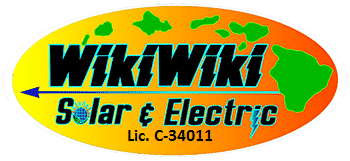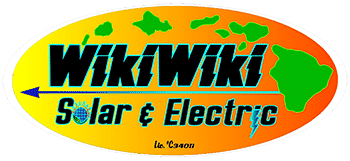The 123s and ABCs of Solar Energy

You’ve heard a lot about the power of solar energy these days, and have seen those panels popping up on rooftops from Lahaina to Hana and everywhere in between. It sure would be nice to find out more, but where to begin? Energy costs have been skyrocketing on our islands for decades, and you’d love to learn more about what solar technology is and how exactly it works. Never fear, at WikiWiki Solar and Electric we’ve got you covered!
A brief primer on solar technology
At its core, photovoltaic (PV) solar technology is the process of converting light into electrical energy via the usage of semiconducting materials. Each PV device is called a cell, and they are composed of various semiconductor materials to convert the sun’s rays into energy. These cells are then linked to one another in bunches known as modules, which can then be linked to one another in panels (what you most often see attached to the roof of a dwelling that has hopped onto the solar energy train!). The panels are linked to the electrical grid in order to provide electrical power to your home, office, or business by converting the sun’s awesome power into electricity. PV systems can also be mounted to the ground, a wall, or maintained in a floating system in addition to being placed on the roof.
So, breaking it all down: sun meets panel, falls in love, creates life-affirming and clean energy for maximum savings. It’s the romance of the century!
Batteries: keeping things charged up
Solar batteries are a little larger than the batteries you’re always running out of for the remote, and a touch more powerful. They allow you to store the excess energy taken in by your PV system instead of having it flow back to the electrical grid. When panels end up producing more energy than your home or business needs, the energy can then flow back into the battery, charging it for storage and future usage. When your panels aren’t drawing any energy from the sun, the battery can supply stored energy when you need it, and only funnels energy back to the grid when it is fully charged. Batteries can also function as a backup to the system when the electrical grid suffers any kind of outage, redirecting previously stored power back to your system.
While a battery is not necessary for a PV system, you wouldn’t be able to store the excess energy that has been cultivated from your system for future usage without one. Solar batteries can even allow you to break free of the power grid altogether! This makes a solar battery a smart investment for your future energy independence and savings needs both now and for years to come.
The ins and outs of PV installation
The solar installation company will prep the installation site and install the electrical wiring necessary to connect your new panels. Racking supports are then affixed to the roof, and the panels are placed directly onto the supports. The number of panels that will be installed depends on several factors, including your unique energy needs and the available space with which to install them. Timelines vary depending on the unique specifications of your new solar system but are usually completed in no more than a few days.
Still have questions? Give us a call!
Each month that you stay stuck to the power company is another month trapped into a utility system without mercy. Rising fossil fuel costs, paying for outdated infrastructure, and being constantly vulnerable to power outages are but a few of the major headaches that can all be avoided by investing in photovoltaic solar energy. Take back control over your energy costs and power your home on your own terms. Get started today with a call to WikiWiki Solar & Electric for your free consultation!


